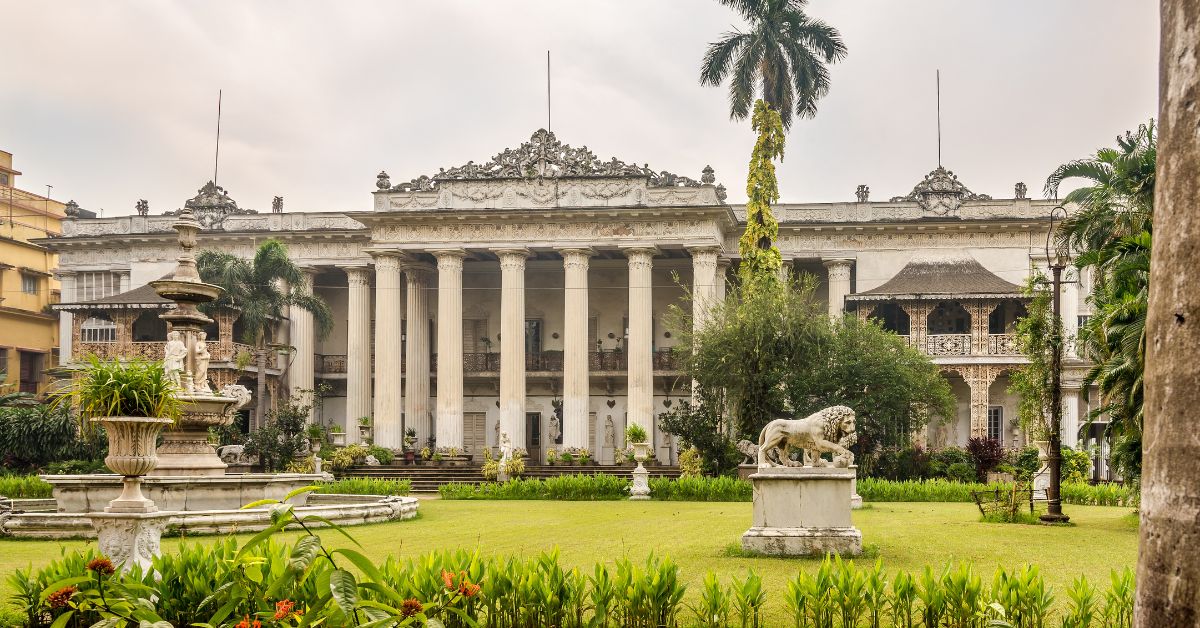Built Using 126 Types of Marble, This Palace Has Cultural Artefacts From Around the World
The Marble Palace in Kolkata is a 19th-century neoclassical mansion built by Raja Rajendra Mullick, featuring a blend of architectural styles and a rich collection of art and artefacts. It is renowned for using 126 types of marble.

Scores of civilisations came and left the earth, but not without leaving indelible imprints upon it in the form of ingenious constructions.
Seven of these made it to a list: ‘Seven Wonders of the Ancient World’ — the protagonists being the Colossus of Rhodes, the Great Pyramid of Giza, the Hanging Gardens of Babylon, the Statue of Zeus at Olympia, the Temple of Artemis at Ephesus, the Mausoleum at Halicarnassus, and the Lighthouse of Alexandria.
While only one of them is still standing, earthquakes and fires destroyed the other six. The Mausoleum of Halicarnauss, for instance, was struck down by successive earthquakes between the 11th and 15th century CE.
In its heyday, the monument was the tomb of Mausolus, ruler of Caria (a region in present-day Turkey). But neither the devastating remains of stone it left behind nor the clouds of dust could erase the memory of the towering marble beauty that people would once gape at in pure wonder. The mammoth facade blended the ideas of Greek architects Pythius and Satyros, with sculptures flanking its sides.
It was beauty personified.
A palace on Muktaram Babu Street in North Kolkata (previously Calcutta, the seat of the British Raj), is said to inspire the same reaction. While people have pointed out a resemblance between the Marble Palace, Kolkata, and the monument in Turkey, there isn’t any sound proof whether the latter inspired the former.
An architectural emblem
A mansion that fuses cultures. This moniker aptly describes the Marble Palace; a white beacon of serenity set against a bustling stretch of land dotted with shops and bazaars. With its neoclassical architecture rising to the skies and its manor-like gates opening up a portal into an alternate dimension — a royal one if you will — the palace is one of the best-preserved private spaces in India.
The name borrows from the 126 types of marble that went into its making. And if that doesn’t tick the box for sheer ingenuity, the host of collections within the museum will. The history of the mansion is coloured and traces back to Raja Rajendra Mullick, a Bengali merchant.
Similar Story

India’s First General Election & More: 8 Iconic Pictures Capturing Indian History
NA
Read more >Adopted by Nilmani Mullick who was a descendant of businessman Ramakrishna Mullick, Rajendra did not want for anything. In 1878, Lord Lytton, viceroy and governor-general, conferred him with the title ‘Raja Bahadur’. At the tender age of 16, Rajendra began building the Marble Palace, completing it by 1840. Today, the grand avenue is a testament to his love for cultures, artistic prowess, and penchant for collectables.
Grandness has its moments
Few are fortunate to be privy to the royal facades and interiors at the Marble Palace. But if you are permitted a private guided tour through the place — possible only by applying through the West Bengal Tourism Information Bureau — prepare to be stunned. The magic lies in the chiselled details. Privacy is prized at this 19th-century home, which explains the stringent rules about having visitors.
But a lucky few who have been within its chambers, speak highly of the palace’s testament to preserving culture. If you look long enough at the block of white, you’ll be able to tell the blend of different architectural styles that have gone into its design.
The neoclassical style Corinthian columns blended with fretwork verandahs and sloping roofs inspired by Chinese architecture, give way to Victorian furniture inside the home. The roof meanwhile is topped with an ornately carved French pediment. The palatial quarters boast five halls: Reception Hall, Painting Room, Sculpture Room, Billiards Room and Thakur Dalan (place of worship).
Each of these rooms bears the nostalgia of the art that Rajendra collected along his travels. He loved dabbling in it; the Bohemian goblets, French Ormulo clocks, swords from Toledo, and Venetian mirrors are proof.
When souvenirs aren’t delighting your senses, huge oil paintings will. These include Rubens’ ‘The Marriage of St Catherine’, ‘The Infant Hercules Strangling the Serpent’ by Joshua Reynolds, paintings by Raja Ravi Varma, Jan Van Goyen, and Giovanni Battista, and sculptures of Venus, Apollo, Homer, and other mythical and real figures.
It is said that the palace houses 76 rare artworks brought from Italy and Belgium in 1830, and a two-cornered biocome that is said to have been worn by Napoleon Bonaparte during his military campaigns. The originality is still debated.
Your way will be illuminated by the light bouncing off the 19th-century disco balls. The palace is a balance between grandeur and a warm place called ‘home’. But while it is the family’s touch for artefacts that draws visitors to the place, it was once the zoo that made headlines.
The Marble Palace is a palatial nineteenth-century mansion in North Kolkata at 46, Muktaram Babu Street. It is one of the best-preserved mansions of nineteenth-century Calcutta. The mansion is famous for its marble walls, floors, and sculptures, from which it derives its name.… pic.twitter.com/M7cvGln1tn— Rupak Chattopadhyay (@RupakChatto) October 13, 2023
Magpies and golden pheasants
In an interview with Telegraph India, Hirendra Mullick — resident and curator of Marble Palace — credited Mullick’s background in botany and ornithology for creating India’s first privately-owned zoo. Called Nilmani Niketan after Rajendra Mullick’s father, the zoo was an attempt to preserve and display herbivores, owing to the family’s vegetarian diet.
Rare birds like albino peacocks, hyacinthine macaw, bird of Alexandria, trucan, hawk-headed parakeets, silver and golden pheasants, magpies, hornbills, and mute swans; long-tailed monkeys, spotted deer, barking deer, red-butt baboon, and porcupines thrived here.
As Hirendra added, “Everything is preserved to protect the glamour and glory of the tradition, history and ambience of the past. Everything is religiously followed as instructed by the founder.”
As the sunlight bathes the sweeping lawns in a yellow glow, the glint bounces off the marble marvel — a symbol of Kolkata’s still-standing royalty.
Edited by Pranita Bhat.
Sources
The past preserved in a Marble Palace by Saurajit Mazumdar, Published on 31 October 2018.
Marble Palace, Kolkata: the story behind Kolkata’s mansion of curiosities by Conde Nast Traveller, Published on 8 February 2022.
The Marble Palace in Kolkata speaks of the grandeur of the Mullicks by Saheli Mitra, Published on 3 May 2024.
The Marble Palace by Rituparna Pal, Published on 22 May.
If you found our stories insightful, informative, or even just enjoyable, we invite you to consider making a voluntary payment to support the work we do at The Better India. Your contribution helps us continue producing quality content that educates, inspires, and drives positive change.
Choose one of the payment options below for your contribution-
By paying for the stories you value, you directly contribute to sustaining our efforts focused on making a difference in the world. Together, let's ensure that impactful stories continue to be told and shared, enriching lives and communities alike.
Thank you for your support. Here are some frequently asked questions you might find helpful to know why you are contributing?











